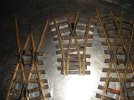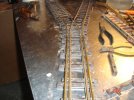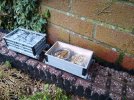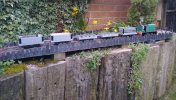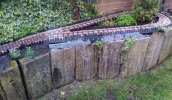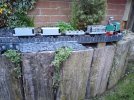After having to lift my second garden railway due to a number of reasons I needed somewhere I could at least run a battery loco and some wagons. We are very limited for space but a possibility was on top of a small narrow raised bed for at least a short end to end railway.
Giving it some thought and the with the knowledge that 0-4-0 Roundhouse battery loco chassis and wagons I have will go round 24" diameter curves without any difficulty the possibility of at least one return loop if not two was worth looking at.
With no budget to speak of I found myself with a load of effectively third hand Peco G45 flexi track, some hardwood faced ply and a need for a railway.
Starting at one end with a return loop of 22" diameter I set about seeing what would fit in the space available and ended up with a complete loop, featuring two tight return loops and a section of interlaced track due to lack of points and a sense of why not.

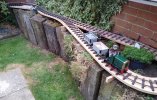
After temporarily laying the track of the ply track bed everything was lifted so that some wood stain protection could be applied to all of the ply and cut ends of the old fence posts used as supports.
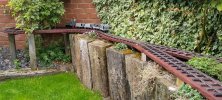
The track was then re-laid and after the inevitable fettling all locos and wagons ran happily round the loop including the interlaced section.
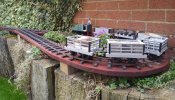
Even with some overly tight curves everything works fine, even when loading with slate and other random stones. Bar couplers greatly improve performance due to the elimination of bunching up and snatching of coupling.
When the warmer weather returns there are a number of scenic improvements I want to carry out including providing some form of slate fence to the track bed and ballast to give it a more natural look as well as some more sympathetic planting to further blend the railway in to the garden.
Not sure what to do with the elevated loop as something like a full on viaduct here would just wrong in the garden.
So far it has cost me about £10 for a fence post which isn't too bad at all until I was then given a couple for free afterwards which was somewhat annoying.
Giving it some thought and the with the knowledge that 0-4-0 Roundhouse battery loco chassis and wagons I have will go round 24" diameter curves without any difficulty the possibility of at least one return loop if not two was worth looking at.
With no budget to speak of I found myself with a load of effectively third hand Peco G45 flexi track, some hardwood faced ply and a need for a railway.
Starting at one end with a return loop of 22" diameter I set about seeing what would fit in the space available and ended up with a complete loop, featuring two tight return loops and a section of interlaced track due to lack of points and a sense of why not.


After temporarily laying the track of the ply track bed everything was lifted so that some wood stain protection could be applied to all of the ply and cut ends of the old fence posts used as supports.

The track was then re-laid and after the inevitable fettling all locos and wagons ran happily round the loop including the interlaced section.

Even with some overly tight curves everything works fine, even when loading with slate and other random stones. Bar couplers greatly improve performance due to the elimination of bunching up and snatching of coupling.
When the warmer weather returns there are a number of scenic improvements I want to carry out including providing some form of slate fence to the track bed and ballast to give it a more natural look as well as some more sympathetic planting to further blend the railway in to the garden.
Not sure what to do with the elevated loop as something like a full on viaduct here would just wrong in the garden.
So far it has cost me about £10 for a fence post which isn't too bad at all until I was then given a couple for free afterwards which was somewhat annoying.
-
9
-
3
-
3
- Show all



